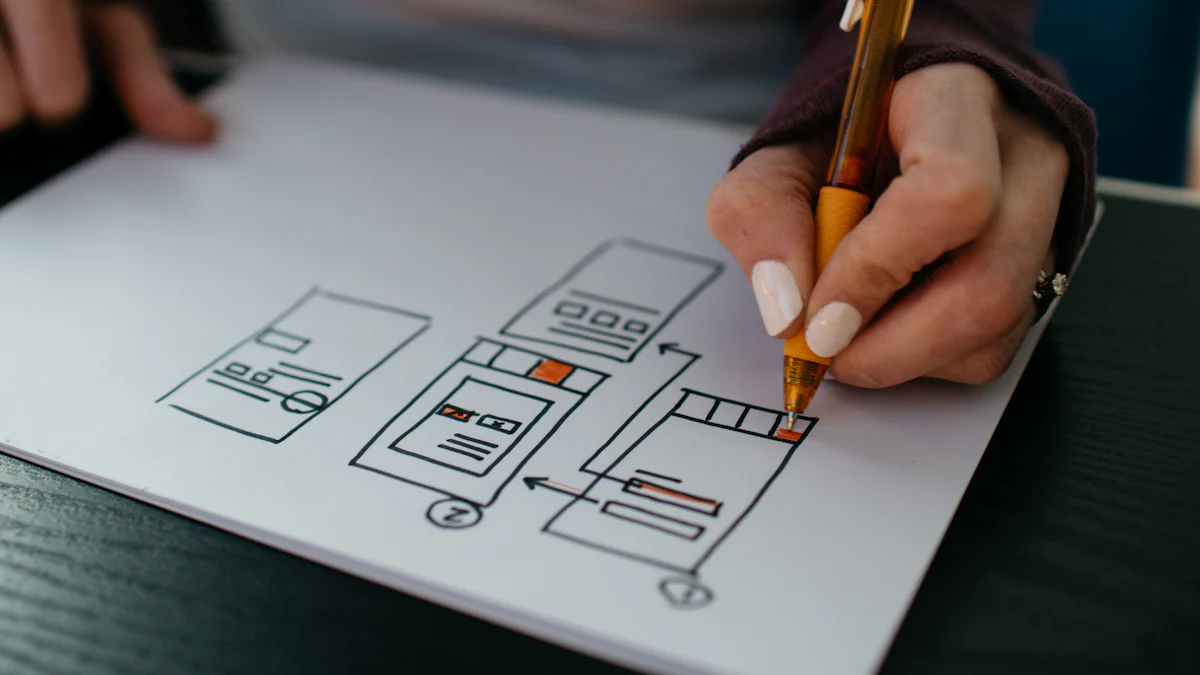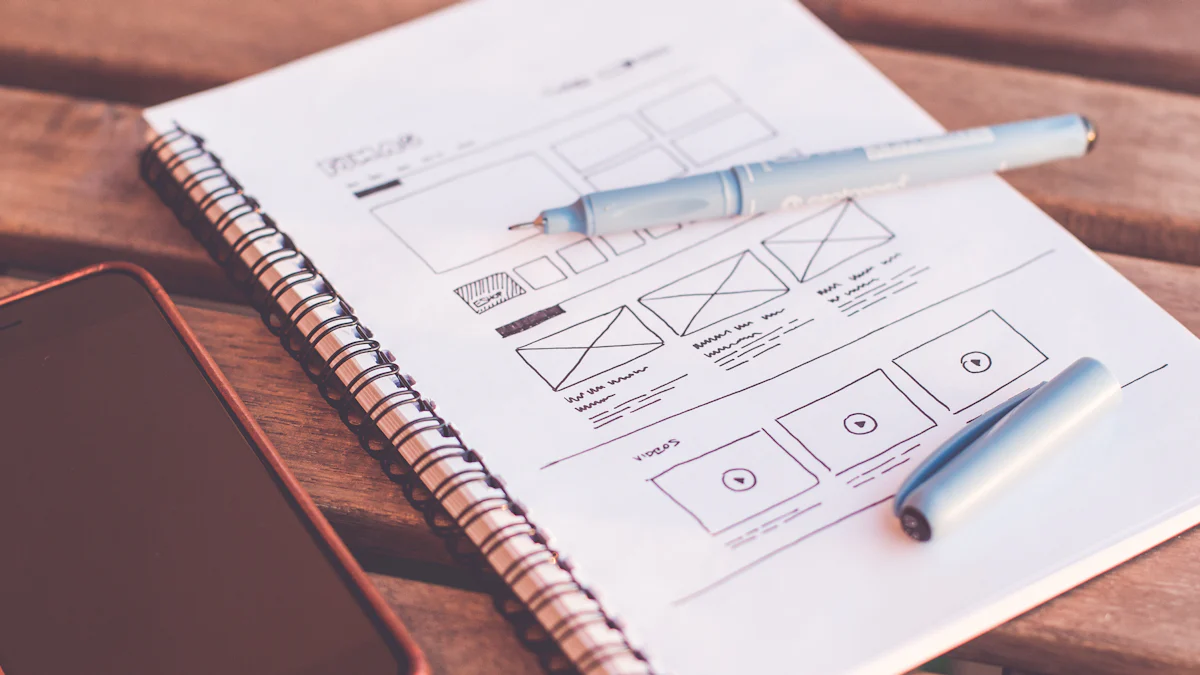the importance of a UX/UI Designer

In today's digital landscape, design matters more than ever. As you navigate the vast online world, first impressions count. A well-crafted user experience (UX) and user interface (UI) can transform your digital presence into a welcoming home for users. Did you know that 75% of users judge a company's credibility based on its website design? This highlights why a UX/UI Designer is crucial. They ensure your platform not only looks appealing but also functions seamlessly. In this digital age, investing in design is not just important—it's essential for success.
Understanding UX/UI Design

In the digital world, understanding UX/UI design is crucial. It shapes how users interact with your product and can significantly impact your success. Let's dive into what UX and UI mean and why they matter to you.
Definition of UX and UI
UX, or User Experience, focuses on the overall feel of the experience. It involves everything from how easy it is to navigate your website to how enjoyable it is to use your app. UI, or User Interface, deals with the look and layout. It includes buttons, icons, and other visual elements that users interact with.
Differences between UX and UI
While UX and UI are closely related, they serve different purposes. UX is about the journey. It ensures that users can achieve their goals smoothly and efficiently. UI, on the other hand, is about the destination. It makes sure that the interface is visually appealing and intuitive. You might think of UX as the architect and UI as the interior designer.
How they complement each other
UX and UI work hand in hand to create a seamless experience. A well-designed UI enhances the UX by making interactions more intuitive. Conversely, a strong UX framework supports the UI by ensuring that the design meets user needs. Together, they form a cohesive whole that delights users and keeps them coming back.
Core principles of UX/UI design
To create effective designs, you need to follow some core principles. These principles guide you in making decisions that enhance user satisfaction and engagement.
User-centered design
User-centered design puts the user at the heart of the process. You gather insights into user needs and preferences and use these insights to inform your design choices. This approach ensures that your product resonates with your audience and meets their expectations.
Accessibility and inclusivity
Accessibility and inclusivity are essential components of good design. You must ensure that your product is usable by everyone, including those with disabilities. By prioritizing accessibility, you not only comply with legal requirements but also expand your reach to a broader audience. Inclusivity fosters a sense of belonging and encourages diverse users to engage with your product.
"Good UX design differentiates a company's product, saves money in the long run, and impacts customer satisfaction levels." - UXCam
By embracing these principles, you create designs that are not only functional but also meaningful. They resonate with users and build lasting relationships. As you continue to explore the world of UX/UI design, remember that your ultimate goal is to create experiences that users love and trust.
The Role of a UX/UI Designer
As a UX/UI Designer, you hold a pivotal role in shaping how users interact with digital products. Your work directly influences user satisfaction and business success. Let's explore the key responsibilities and essential skills that define your role.
Key responsibilities
Research and user analysis
You begin by diving deep into research and user analysis. This step involves understanding user needs, behaviors, and pain points. By conducting thorough user experience research, you gather valuable insights that guide your design decisions. This research ensures that your designs resonate with users and address their real-world challenges.
Wireframing and prototyping
Next, you move on to wireframing and prototyping. These tools allow you to visualize the structure and functionality of a product before it's fully developed. Wireframes serve as blueprints, outlining the layout and flow of the user interface. Prototypes bring these wireframes to life, enabling you to test and refine interactions. This iterative process helps you create intuitive and user-friendly designs.
Essential skills and tools
Design software proficiency
To excel as a UX/UI Designer, you must master various design programs. Proficiency in tools like Adobe XD, Sketch, and Figma is crucial. These programs empower you to create stunning visuals and interactive prototypes. Your ability to navigate these tools efficiently enhances your productivity and creativity.
Communication and collaboration
Effective communication and collaboration are equally important. You work closely with cross-functional teams, including developers, product managers, and stakeholders. Clear communication ensures that everyone shares a common vision and understanding of the project goals. Collaboration fosters innovation and leads to more cohesive and successful designs.
"This guide to hiring UX designers features an overview of relevant skills, job description tips, and interview questions and answers that will help you identify the best candidates for your company." - Toptal UX Designer Job Description Guide
By embracing these responsibilities and honing these skills, you become an invaluable asset to any organization. Your work as a UX/UI Designer not only enhances user experiences but also drives business growth. Remember, your designs have the power to inspire and transform the digital landscape.
Benefits of Hiring a UX/UI Designer
In the digital world, hiring a UX/UI Designer can transform your business. Their expertise in crafting exceptional user experiences can lead to significant benefits. Let's explore how they enhance user experience and provide business advantages.
Enhancing User Experience
Improving usability and satisfaction
A UX/UI Designer focuses on creating memorable user experiences. They ensure that your platform is intuitive and easy to navigate. This attention to detail improves usability and boosts customer satisfaction. When users find your site or app easy to use, they are more likely to return. This positive interaction builds a strong connection between your brand and your audience.
Reducing user errors
Reducing user errors is another key benefit of effective UX/UI design. By anticipating potential pitfalls, designers create interfaces that guide users smoothly through tasks. This proactive approach minimizes frustration and enhances the overall user experience. As a result, users feel more confident and satisfied with their interactions.
Business advantages
Increasing conversion rates
Investing in UX/UI design services can significantly boost conversion rates. A well-designed interface not only attracts users but also encourages them to take action. Studies show that UI can increase conversion rates by up to 200%, while UX can achieve an impressive boost of up to 400%. This increase directly impacts your bottom line, making the design process important for achieving business goals.
Building brand loyalty
A strong UX/UI design fosters customer loyalty. When users have positive experiences, they are more likely to become repeat customers. This loyalty translates into long-term business success. By partnering with a design agency, you ensure that your brand consistently delivers exceptional user experiences. This commitment to quality strengthens your brand's reputation and keeps customers coming back.
"Every dollar invested in UX design brings $100 in return." This remarkable return on investment highlights the value of prioritizing user experience in your business strategy.
Practical Applications of UX/UI Design
In the world of digital design, practical applications of UX/UI design showcase how theory transforms into real-world success. By examining case studies and industry-specific applications, you can see the tangible impact a UX/UI Designer has on user experience and business growth.
Case Studies of Successful Designs
Case Study: E-commerce Success
Imagine an e-commerce platform struggling with low conversion rates. A skilled UX/UI Designer steps in to revamp the user experience. They focus on intuitive navigation, clear calls to action, and engaging animations. The result? A seamless shopping journey that boosts conversion rates by 30%. This transformation highlights the power of thoughtful design in driving business success.
Case Study: Mobile App Innovation
Consider a mobile app aiming to stand out in a crowded market. The UX/UI Designer employs vibrant color schemes and smooth animations to create a visually appealing interface. By prioritizing user-centered design, they ensure the app meets user needs and expectations. This approach not only enhances user satisfaction but also increases downloads by 50%. Such innovation showcases the vital role of design in app success.
Industry-Specific Applications
E-commerce
In e-commerce, user experience is everything. A UX/UI Designer crafts interfaces that guide users effortlessly from browsing to checkout. By focusing on user-friendly layouts and engaging visuals, they enhance the shopping experience. This attention to detail leads to higher conversion rates and increased customer loyalty.
Mobile Applications
Mobile app services thrive on exceptional user experience. Designers like Kris Secor and Denitsa Kostova understand the importance of intuitive interfaces and engaging animations. By integrating these elements, they create apps that users love. This commitment to quality ensures ongoing app assistance and long-term success.
"A well-executed design can transform an ordinary app or website into a top-class experience." - Diego Division of Extended Studies
By exploring these practical applications, you gain insight into how UX/UI design shapes user experiences and drives business growth. Whether in e-commerce or mobile applications, the impact of a talented UX/UI Designer is undeniable. Embrace the power of design to elevate your digital presence and achieve your goals.
Future Trends in UX/UI Design

As a UX/UI Designer, you stand at the forefront of innovation. The future holds exciting possibilities that will transform how you create experiences. Let's explore why emerging technologies and evolving user expectations are crucial for your design journey.
Emerging technologies
AI and machine learning
AI and machine learning are revolutionizing experience design. You can harness these technologies to create personalized experiences that adapt to user behavior. Imagine an app that learns from user interactions and offers tailored suggestions. This level of customization enhances user satisfaction and keeps them engaged. By embracing AI, you position yourself as a leader in innovative design.
Virtual and augmented reality
Virtual and augmented reality open new dimensions in experience design. These technologies allow you to create immersive environments that captivate users. Picture an app where users explore a virtual world, interacting with elements in real-time. This experience goes beyond traditional interfaces, offering something truly unique. By integrating VR and AR, you elevate your design skills and offer unforgettable experiences.
Evolving user expectations
Personalization
Users now expect personalized experiences. They want content and interfaces that reflect their preferences. As a UX/UI Designer, you can leverage data to tailor experiences to individual needs. This approach builds a deeper connection with users, making them feel valued. Personalization is not just a trend; it's a necessity for creating meaningful interactions.
Seamless experiences
Seamless experiences are the hallmark of effective design. Users desire smooth transitions between devices and platforms. Your role involves ensuring that interactions flow effortlessly. By focusing on consistency and coherence, you enhance user satisfaction. A seamless experience keeps users engaged and loyal to your brand.
"The future belongs to those who believe in the beauty of their dreams." - Eleanor Roosevelt
By embracing these trends, you unlock new opportunities in experience design. You have the power to shape the future of digital interactions. Stay inspired and continue to innovate. Your work as a UX/UI Designer will lead to experiences that delight and inspire.
UX/UI Designers play a vital role in shaping your digital presence. Their work enhances user engagement, satisfaction, and conversion rates. By investing in quality design, you not only improve user experiences but also boost brand loyalty and revenue. Companies like DuckMa exemplify how a well-thought design process can transform digital products. Embrace the future of design by partnering with a Digital Product Dev Partner like DuckMa. Avoid bad design pitfalls and ensure your platform stands out. Remember, good design is not just an option—it's essential for success.
See Also
Effective Time Management for Remote Employees
